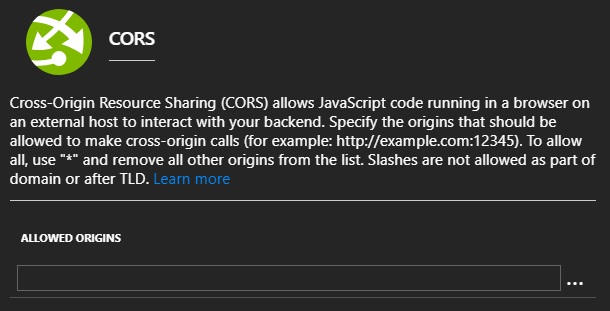Calling Azure AD Secured Azure Function Externally From JavaScript
My customer recently had a need to securely call an HTTP trigger on an Azure Function remotely from an arbitrary client web application. In this scenario securely meant ensuring that the user has logged into Azure Active Directory (AAD), but any number of authentication providers could be used. The SharePoint Patterns and Practices (PnP) team had posted a video (SharePoint PnP Webcast – Calling external APIs securely from SharePoint Framework) that used the SharePoint Framework but my team needed to do this from vanilla JavaScript. Many thanks to the PnP team and my peer Srinivas Varukala for their inspiration and code samples.
Overview
The key components to this solution involve the following:
- Azure AD app registration (used to enforce authentication on Azure Function)
- Azure Function configured to enforce Azure AD authentication
- Client web application with JavaScript code to call the Azure Function
Azure Function
In the Azure Portal create a new Azure Function. Choose an HTTP Trigger and use the language of choice (I’m using C# script in this example). The Azure Function will validate if a claims principal exists on the incoming request and then output to the logs the name of the user if authenticated.
<Update 2018-05-02>
Note: the Azure portal currently does not support the headers required for CORS (cross-origin resource sharing) requests that contain credentials. Feedback (source) has been provided to the Azure App Service team to support this but was declined. As such the manual processing of CORS requests is not supported at this time. You will need to determine if this workaround works for you or not.
</Update 2018-05-02>
|
1
2
3
4
5
6
7
8
9
10
11
12
13
14
15
16
17
18
19
20
21
22
23
24
25
26
27
28
29
|
using System.Net;using System.Security.Claims;using System.Threading;public static HttpResponseMessage Run(HttpRequestMessage req, TraceWriter log){ log.Info("C# HTTP trigger function processed a request.");// check for authenticated user on incoming request if (!ClaimsPrincipal.Current.Identity.IsAuthenticated) { log.Info("Claims: Not authenticated"); } else { log.Info("Claims: Authenticated as " + ClaimsPrincipal.Current.Identity.Name); } var resp = req.CreateResponse(HttpStatusCode.OK, "Hello there " + ClaimsPrincipal.Current.Identity.Name); // manually process CORS request if (req.Headers.Contains("Origin")) { var origin = req.Headers.GetValues("origin").FirstOrDefault(); resp.Headers.Add("Access-Control-Allow-Credentials", "true"); resp.Headers.Add("Access-Control-Allow-Origin", origin); resp.Headers.Add("Access-Control-Allow-Methods", "GET, POST, OPTIONS"); resp.Headers.Add("Access-Control-Allow-Headers", "Content-Type, Set-Cookie"); } return resp;} |
Azure AD App
In order to enforce Azure AD authentication on the Azure Function an Azure AD app registration needs to be created. Log into the Azure AD admin portal. Under Azure Active Directory –> App Registrations create a new app registration.

Take note of the Application ID (also known as client ID) for the application created. This will be used later in the Azure App Service authentication / authorization configuration.

The default permissions for the Azure AD app registration (delegated: sign in and read user profile) will be sufficient.


Enforce authentication
Return to the Azure Function and navigate to the Platform features –> Authentication / Authorization screen. Turn App Service Authentication to On, set “Action to take…” to “Log in with Azure Active Directory”, then click the Azure Active Directory authentication provider to configure it as follows.

Fill in the Application ID / Client ID from the previously created Azure AD app registration. Specify the IssuerUrl of the Azure AD domain (typically https://login.microsoftonline.com/TENANT_NAME_GOES_HERE.onmicrosoft.com).

Remove CORS configuration
As noted previously, the Azure portal currently (as of writing May 1, 2018) does not support Azure App Service processing CORS requests that contain credentials. As such removing all domains from the CORS configuration in Azure Portal is unsupported. Please validate if this workaround works for you or not.

Client code
In this example I started with a .Net Framework MVC project from Visual Studio 2017 v15.6.7 but the code could be hosted on any page with HTML, JavaScript, and a logged in user to Azure AD. Note that the MVC project allows enforcing Azure AD authentication which is what I was most interested in.


HTML snippet to include inside of an IFRAME element with source pointing to root of Azure Function.

<Update 2019-04-11> After the IFRAME has loaded and authenticated you should see a cookie tied to the domain hosting the Azure Function. See following for successful setting of the auth cookie.

If this cookie is not set (ex. cookie size is too large, request / response headers deny the cookie, cookies not allowed by policy, etc.) the outgoing AJAX request will not be able to satisfy the authentication requirement which will result in an error. See following for sample issues that could be encountered when setting the auth cookie.

</Update 2019-04-11>
JavaScript snippet to call HTTP trigger of Azure Function.
Note that in a production scenario you would want to ensure that the IFRAME has loaded fully (and thus authentication cookie set) prior to the Azure Function being called.
|
1
2
3
4
5
6
7
8
9
10
11
12
13
14
15
16
17
18
19
20
21
|
$(document).ready(function () { $("#btnExternalCall").click(function (e) { var serviceURL = "https://NAME_OF_AZURE_FUNCTION_GOES_HERE.azurewebsites.net/api/HttpTriggerCSharp1"; $.ajax({ url: serviceURL, type: "GET", xhrFields: { withCredentials: true }, crossDomain: true, success: function (data) { alert("Success: " + data); }, error: function (ex) { alert("Failure getting user token"); } }); });}); |
Testing
When all has been configured you can test scenario. If you enter F12 developer tools from your browser of choice you should see the authentication cookie for both the client web application as well as the Azure Function domains.

After issuing the call to the HTTP Trigger on the Azure Function you should see that the call was indeed authenticated and the ClaimsPrincipal is returned.


Conclusion
This is a very powerful capability being able to ensure that an HTTP trigger on an Azure Function only allows authenticated users to call the endpoint. Hopefully this post helps others who have a similar need. Please leave and questions or feedback in the comments below.
